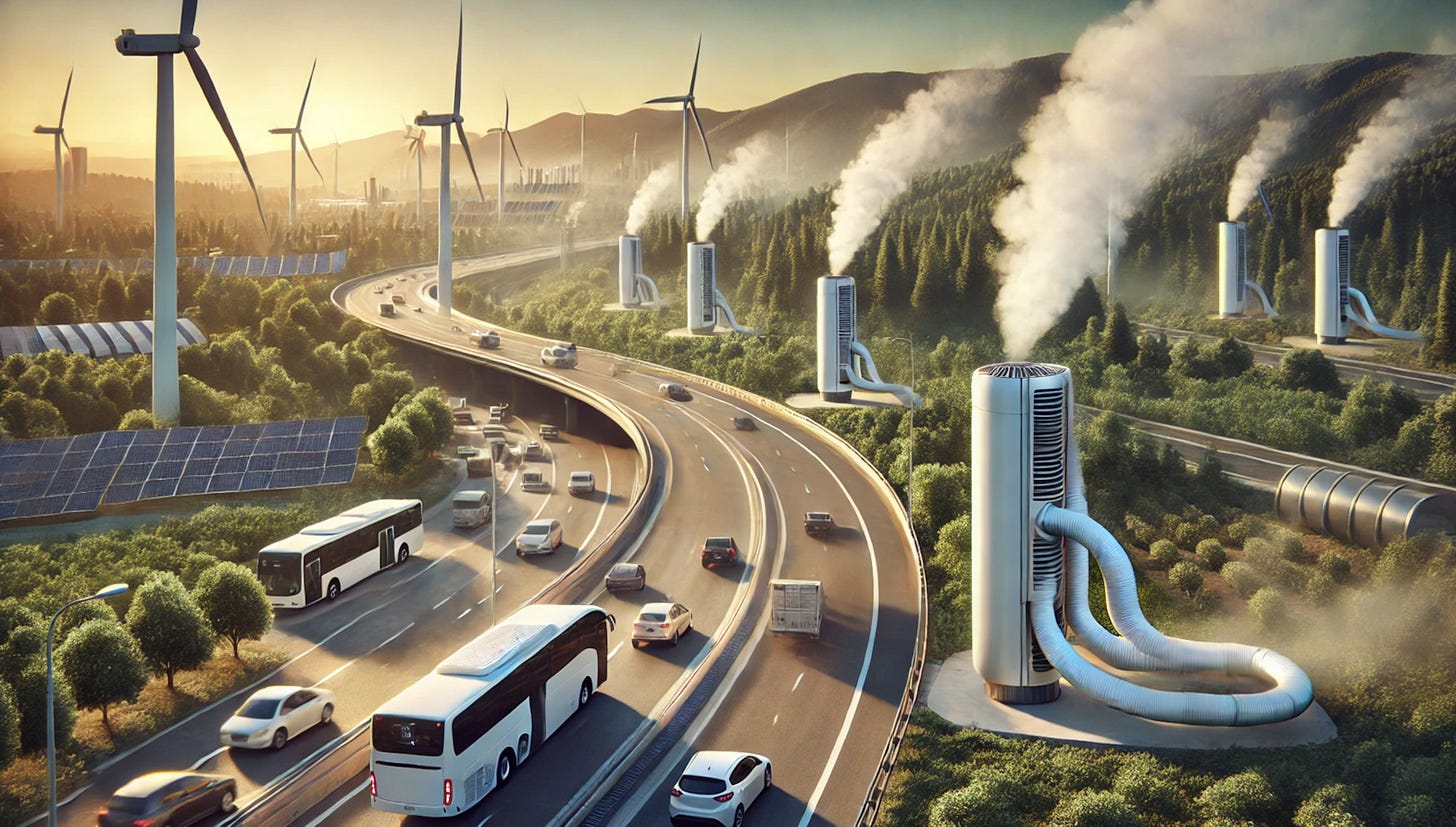Microsoft’s Carbon Experiment
Applying the Three Futures Test to Forecast Microsoft’s Carbon Strategy
This is a continuation of a series of posts that began with “Why Being Late Can Still Mean Capturing 90% of the Upside”. The series aims to share some of the future forecasting methodologies being applied as a new stage-gate of our Due Diligence framework.
Part 1: Why Being Late Can Still Mean Capturing 90% of the Upside
Part 2: The Three Futures Test
Part 3: Applying Futurist Methodologies Empower AI-Enhanced Due Diligence
Listen to the AI Narrated commentary overview of the post:
The idea for applying the Three Futures Test to Microsoft’s Carbon strategy came from a conversation with my friend, David, who asked me, “What do you think is driving Microsoft’s big push into carbon removal?”
To answer, I applied the Three Futures Test to evaluate how Microsoft might be thinking about their carbon removal investments.
By using the Three Futures Test, I probabilistically forecast three plausible scenarios that could explain why Microsoft is investing in carbon removal today and how this could ultimately become a trillion-dollar industry.
Each scenario leads to one essential outcome: if any of these futures materializes, carbon removal will be critical, and those who position themselves early will benefit from a transformed market.
Microsoft’s Three Futures
The Three Futures Test assesses three possible scenarios for the future of technology and energy. This exercise demonstrates how carbon removal could shift from an environmental initiative to an economic necessity, creating a foundational asset class for the future.
Microsoft’s commitment to carbon removal might be rooted in this kind of long-term foresight, anticipating an inevitable surge in demand for carbon management.
Future 1: Robotics and AI Drive Unprecedented Demand for Energy
1. The Rise of Robotics and AI
In this future, robotics and AI become central across industries, requiring enormous computational resources. As more industries adopt advanced automation, the demand for GPUs, data centers, and compute power escalates dramatically, driving up energy consumption across sectors.
2. Energy Demand Outpaces Supply
While renewable energy sources continue to grow, they may not meet the scale of demand in time. In regions where renewable infrastructure lags, fossil fuels could remain a primary energy source, exacerbating emissions.

Implication - Carbon removal becomes necessary as a way to manage the emissions from a growing tech-driven economy. Here, carbon removal is a structural requirement, allowing robotics and AI to expand without compounding climate risks. Microsoft’s investment in carbon removal might be a hedge against this future, ensuring stability in a high-demand energy landscape.
Future 2: AI and Crypto Emerge as Major Energy Consumers
1. AI and Crypto as Energy Giants
In this scenario, AI technologies and cryptocurrency mining become some of the largest consumers of energy. AI needs constant power for compute-heavy processes, while crypto mining requires energy-intensive proof-of-work algorithms to operate securely.
2. Economics Favor Cheap Energy
Both sectors are likely to prioritize the cheapest energy sources to remain competitive, which could mean continued fossil fuel reliance where renewable options aren’t economically viable. This future sees fossil fuel demand rising, driving up emissions.

Implication - In this future, carbon removal is essential for balancing emissions. Carbon removal shifts from a “nice-to-have” to a requirement for sustaining economic growth in a high-energy, high-emission scenario.
Microsoft’s early carbon removal investments could be a strategic move to mitigate this risk (of regulatory and climate risk), setting the stage for a carbon economy capable of supporting both AI and crypto industries without environmental collapse.
Future 3: Carbon Removal becomes essential for Economic and Environmental Stability
1. Carbon Removal as Core Infrastructure
In this envisioned future, carbon removal becomes as indispensable as energy grids, water systems, and transportation networks. It is no longer a supplementary tool in climate strategy but rather a foundational pillar of modern civilization.
The value of carbon removal credits transforms from an abstract concept into a concrete asset class, measured by metrics like durability (how long carbon is sequestered), project quality (environmental integrity and co-benefits), and deliverability (scalability and reliability).
Extrapolation:
Imagine a world where carbon removal systems dot the landscape like wind turbines and solar farms today. Direct air capture units hum quietly along highways, absorbing atmospheric CO₂ as cars once guzzled fossil fuels. These systems plug directly into economic networks, becoming integral to the balance sheets of nations and corporations alike.
Carbon credits evolve into multi-dimensional assets. Their value is not just monetary but symbolic, representing a nation’s or company’s commitment to a sustainable & resilient future. These credits might even be listed alongside traditional commodities like oil and gold, signaling their centrality to economic systems.
2. A Sophisticated Carbon Economy Emerges
As the cumulative impacts of rising energy demand and emissions collide with physical and ecological limits, an urgent need arises to formalize and scale carbon management. This catalyzes the development of a Carbon Stock Exchange—a financial marketplace where carbon credits, bonds, and derivatives trade with the same fervor as equities or commodities today.
The creation of a sophisticated carbon economy doesn't happen in isolation. It interconnects with broader economic and environmental systems:
Energy Markets: Renewable energy companies leverage carbon credits as collateral, driving further investment in clean technologies.
Insurance and Risk Management: Carbon removal assets serve as a hedge against catastrophic climate impacts, reducing risk premiums for corporations and governments.
Geopolitics: Nations with significant carbon removal capacities gain strategic leverage, potentially reshaping power dynamics much like oil reserves once did.
This trillion-dollar industry becomes a fusion of environmental stewardship and economic opportunity, where the urgency of climate action converges with the ambition of market forces.
3. Market-Driven Incentives
As the carbon economy matures, market mechanisms drive adoption. Long-term carbon investments—analogous to renewable energy credits or green bonds today—become mainstream. Governments and financial institutions introduce preferential capital gains rates for holding carbon credits, rewarding patience and long-term thinking.
Microsoft’s pioneering investments in carbon removal position it as a model for corporations seeking both financial returns and reputational capital. Early movers benefit not only from asset appreciation but also from preferential regulatory treatment and increased investor confidence.
Extrapolation:
Imagine a "Carbon Removal Credit Score" akin to a personal credit score but applied to companies. Higher scores unlock financial perks such as reduced loan rates or tax breaks, creating a self-reinforcing loop where businesses that actively remove carbon become more competitive and financially robust.
Why Carbon Removal Could Be the Next Trillion-Dollar Industry
If Future 1 or Future 2 unfolds—or, more likely, both manifest to varying degrees—carbon removal shifts from an optional strategy to an economic imperative. It’s envisioning our economy transitioning from carbon emitting to a carbon balancing economy. Here’s why this sector holds transformative potential:
1. The Carbon Stock Exchange as a Wealth Multiplier
As demand for carbon removal assets grows, early adopters reap exponential rewards. A Carbon Stock Exchange incentivizes innovation in carbon capture technologies and ecosystem restoration, creating a feedback loop that rewards both ecological impact and financial foresight.
This wealth multiplier effect doesn't just benefit investors; it accelerates the democratization of climate action. Just as renewable energy adoption lowered electricity costs globally, scaling carbon removal reduces the societal costs of climate disruptions. Communities become shareholders in the planet’s recovery, aligning economic incentives with environmental justice.
2. Carbon Removal as a Hedge Against Climate Disruption
In a world of increasing uncertainty, carbon removal assets serve as both a financial and ecological hedge. They stabilize portfolios against the volatility of climate impacts while aligning with global decarbonization goals.
Systems Insight:
This dynamic introduces a virtuous cycle:
Carbon removal projects reduce atmospheric CO₂, mitigating climate risks.
Reduced risks lower insurance costs and stabilize financial markets.
Stability attracts more capital to carbon removal, driving innovation and scale.
By embedding climate resilience into the economy, we create a buffer against systemic shocks, from agricultural disruptions to infrastructure damage.
3. Financial and Social Perks
The maturation of carbon markets could introduce a range of tangible benefits for stakeholders. For instance:
Individuals and companies holding carbon credits may receive tax incentives or reduced loan rates, creating a financial premium for climate-conscious behaviors.
Governments might offer bond-backed guarantees for large-scale carbon projects, blending public and private capital for shared benefits.
Microsoft and similar companies could pioneer carbon-conscious retirement funds where employees allocate a percentage of their 401(k) to carbon removal investments. These funds grow in value while directly contributing to climate stability, embedding environmental responsibility into personal wealth creation.
Applying the Three Futures Test reveals that carbon removal could emerge as not just a peripheral sustainability effort but a cornerstone of future economic systems. Microsoft’s early investments underscore a recognition of carbon removal as both a hedge against climate risks and a growth opportunity in a foundational industry.
This is a future where visionary capital catalyzes global transformation. By embedding carbon removal into the DNA of the economy, we lay the groundwork for a resilient, prosperous world where environmental and economic goals are no longer in conflict but are synergistically aligned.
The question is not whether this future will materialize but who will shape it. Investors who act today position themselves not just as beneficiaries of economic growth but as architects of a sustainable tomorrow.
Using probabilistic reasoning, the analysis of Microsoft’s carbon removal strategy reveals critical insights into the intersection of energy demand, technological evolution, and climate stabilization.
By evaluating the likelihood of each scenario and incorporating foresight methodologies—such as systems thinking, scenario planning, and weak signal detection—it becomes evident that carbon removal is not just a sustainability initiative but a future economic pillar. Signals like the exponential rise of energy-intensive technologies, the pace of renewable scaling, and the increasing urgency of climate action all point toward the inevitability of this transition.
An important consideration in this analysis is the growing volatility of climate-driven weather events, which could severely disrupt the scaling of renewable energy systems. Wind turbines and solar farms, reliant on predictable patterns, face vulnerabilities that many optimistic assumptions often overlook. This volatility not only threatens energy reliability but also amplifies the awakening of climate risks for governments, corporations, and society at large. As these disruptions intensify, fringe concepts like carbon removal and geo-engineering are likely to move to the forefront of global strategies.
Microsoft’s forward-looking investments exemplify long-term thinking, positioning them as early movers in what could become a trillion-dollar industry. Their approach is not merely a hedge against climate risks but a deliberate act of shaping a future economy where environmental resilience and economic growth are deeply intertwined. This strategy demonstrates the transformative potential of acting early in probabilistic markets, turning uncertainty into opportunity.
Even if only one of the three futures—or a hybrid—materializes, those who act now will have redefined the economic landscape. Carbon removal isn’t just about mitigating climate impacts; it’s about catalyzing new markets, fostering resilience, and constructing the scaffolding for a prosperous, equitable future. This is where foresight becomes a competitive advantage—identifying and advancing transformative shifts before they become urgent necessities.
For those interested in exploring these ideas further, a shout-out to the podcast I’ve helped to launch & produce, Climate on the Edge, where our host, Susan Su, delves into climate technologies at the frontier, including carbon removal and geo-engineering. We recently covered a series on leading Carbon Removal technologies at the X Prize Carbon Removal summit.
Next week, I’ll continue the Three Futures Test series by covering the Blueprint for creating these forecasting scenarios. This includes a deep dive into the AI-powered workflow, strategies for curating a dynamic knowledge base, and the integration of probabilistic practices to enhance decision-making.



